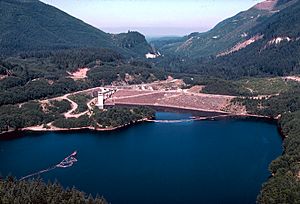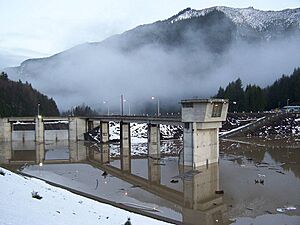Howard A. Hanson Dam facts for kids
Quick facts for kids Howard A. Hanson Dam |
|
|---|---|

Howard A. Hanson Dam (rear)
|
|
| Location | King County, Washington, USA |
| Construction began | 1959 |
| Opening date | 1961 |
| Operator(s) | U.S. Army Corps of Engineers |
| Dam and spillways | |
| Impounds | Green River |
| Height | 235 ft (72 m) |
| Length | 675 ft (206 m) |
| Width (crest) | 23 ft (7 m) |
| Width (base) | 960 ft (292 m) |
| Spillway type | Service, controlled |
| Spillway capacity | 107,000 cubic feet per second (3,000 m3/s) |
| Reservoir | |
| Creates | Howard A. Hanson Reservoir/Pool |
| Total capacity | 106,000 acre⋅ft (131,000,000 m3) |
| Catchment area | 220 square miles (570 km2) |
The Howard A. Hanson Dam is a large dam made of earth and rock. It sits on the Green River, about 21 miles (34 km) east of Auburn, Washington. This dam was finished in 1961. Its main jobs are to stop floods and provide water for the city of Tacoma, Washington.
In January 2009, the water behind the dam reached very high levels. After this, the U.S. Army Corps of Engineers found that water was leaking from the side of the dam. They worked hard to fix this problem and prevent a possible flood. By October 2011, they had improved the dam's drainage system. Even though studies are still happening, the dam is now considered safe to hold its maximum amount of water.
Contents
Building the Howard A. Hanson Dam
Early Flooding Problems
The Green River Valley was settled in the 1850s. It became a popular area for farming. However, farmers often had to deal with yearly floods. These floods would cause huge piles of logs to block the river, changing its path. Sometimes, farmers even used dynamite to clear these log jams, which could cause flooding on other farms.
To solve these problems, local groups formed the Associated Improvement Clubs of South King County in 1926. They built some protective walls called dikes and fixed river paths. But they soon realized they needed more help to control the powerful river.
Planning and Construction
In 1936, community leaders, citizens, and the U.S. Army Corps of Engineers (USACE) began looking for a good place to build a flood control project on the Green River. The search was delayed by World War II. Finally, in 1949, a place called Eagle Gorge was suggested as the best spot for a dam and reservoir.
In 1955, money was set aside for the project. The U.S. Congress gave $37 million, Washington State gave $1.5 million, and King County provided $500,000. Building the dam started in February 1959. This included moving 13 miles (21 km) of Northern Pacific railway tracks.
During construction in December 1959, the Green River had one last big flood. It damaged homes and washed away valuable topsoil from farms. Despite this, the dam was finished almost five months early, on Christmas Day, 1961. The completion of the dam ended 70 years of flooding in the Green River Valley. By 1996, the dam had prevented an estimated $694 million in flood damages.
Naming the Dam
The dam was first called the Eagle Gorge Dam. But in 1958, Congress renamed it the Howard A. Hanson Dam. Howard A. Hanson was a key leader who worked with community and government groups to get the dam built. He was very important in getting the money needed for the dam. Sadly, Hanson died in 1957, before construction even began.
How the Dam Works
The Howard A. Hanson Dam is a large wall of earth and rock. It is 675 feet (205 meters) long and 235 feet (70 meters) high. The bottom of the dam is 960 feet (290 meters) wide. It sits inside Eagle Gorge, which is a deep valley with steep rock walls.
The reservoir behind the dam collects water from a 220 square mile (570 km²) area. This reservoir is about 7 miles (11 km) long. The dam has a concrete spillway on its left side. This spillway can release extra water if the reservoir gets too full. It is controlled by two large gates. There is also an outlet tunnel at the bottom of the dam with two other gates to control water flow.
The dam's main job is flood control during the rainy season. It collects floodwaters and then slowly releases them through the tunnel at the bottom. This happens whenever needed. The spillway has never had to be used, even during extreme floods.
In March, the dam starts to save water. During the summer, it releases specific amounts of water. This helps fish like salmon migrate and lay their eggs. It also helps with sports fishing. In the winter, the reservoir is kept mostly empty.
The dam is located in the Tacoma watershed, which is an area that collects water for the city. Because of this, people are not allowed to visit the dam. This has caused some debate among people who want to use the area for recreation. Water released from the dam goes to a water purification plant about 3 miles (5 km) downstream. There, it is cleaned for people to drink and use.
Dealing with Flooding Concerns
In January 2009, 15 inches (38 cm) of rain fell in just 24 hours. This caused the water flowing into the reservoir to reach its highest point. The reservoir's water level rose to a record 1,189 feet (362 meters) above sea level. For comparison, the highest allowed storage level is 1,206 feet (368 meters), and the normal summer level is 1,167 feet (356 meters). The Howard A. Hanson Dam successfully controlled this flood, preventing an estimated $4 billion in damages.
However, after this flood, the USACE found two dips on the right side of the dam. They also noticed more water in their groundwater monitoring wells and saw water with dirt entering a drainage tunnel on the dam's side. The USACE did not think the dam was in immediate danger of breaking. But they did believe there was a higher risk for communities downstream until the problem was fixed.
The USACE began to lower the amount of water allowed in the dam's reservoir. Also, by November 2009, they built a temporary wall to stop leaks and improved the drainage on the right side of the dam. These actions were expected to reduce the chance of flooding from 1 in 3 to 1 in 25 during 2010.
The reservoir's water level was kept lower because of the increased chance of flooding downstream. If a major flood happened, releasing too much water could cause it to flow over the protective walls further down the river. Sandbags were given out across the Green River Valley as the USACE continued to check, watch, and fix the dam. After the dam's drainage improvements were finished in October 2011, it was declared safe to hold its maximum amount of water again. A full study of the dam is still ongoing.
Images for kids






